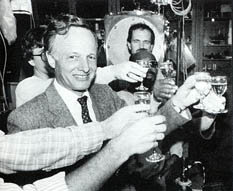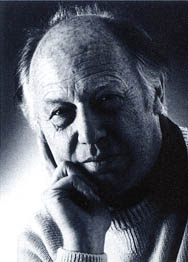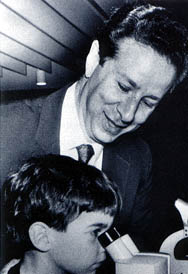Nobel Laureates
Eight Scientific Researchers
Who Discovered...
Guessing the number of Canadians who have
won the Nobel Prize for scientific discoveries might well be a question
for the TV game show Jeopardy, but the answer would be open to debate,
for at least three of the eight recipients were born in other countries
and four of the five native-born winners were recognized for research accomplished
in the United States.
Six scientists have won outright or jointly
won, a Nobel Prize for chemistry and two have won for physics. Three of
the chemistry winners were born elsewhere: Gerhard Herzberg, born in Germany,
left in 1935 because his wife was Jewish; John Polanyi, a University of
Toronto professor, was also born in Germany; and Michael Smith, now at
the University of British Columbia, is a native of Blackpool, England.
The first Canadian-born chemist to with
the Nobel Prize was Henry Taube, from the mixed-farming community of Neudorf,
Saskatchewan, for studies accomplished at three American universities.
The other two, natives of Montreal, were Rudolph Marcus and Sidney Altman.
Two Alberta-born scientists have won the
Nobel Prize for physics: Bertram Brockhouse in 1994 for discoveries made
40 years earlier at Chalk River, Ontario, and Richard Taylor for researching
subatomic particles called "quarks." He was jointly awarded the Nobel Prize
with two Americans in 1990.
Gerhard Herzberg
After Dr. Herzberg came to Canada as a
31-year-old accomplished scientist, he remained at the University of Saskatchewan
for a decade, becoming a Canadian citizen in 1945. Following a three-year
stint at the University of Chicago's Yerkes Observatory, he was hired as
principal research officer for the Division of Physics at the National
Research Council (NRC) in Ottawa. He became director a year later and,
in 1955, director of the Division of Pure Physics.
 |
Gerhard Herzberg left
Germany for Canada in 1935. A highlight of his near 50-year career at Ottawa's
National Research Council was winning the 1971 Nobel Prize for chemistry
for research work in the spectroscopic analysis of free molecules. [Photo,
courtesy National Research Council/Harry Turner] |
By then his interest had shifted to the
more difficult spectroscopic analysis of free radicals (atoms or molecules
with at least one unpaired electron). This research led to his Nobel Prize
for chemistry in 1971.
Herzberg was president of the International
Union of Pure and Applied Physics from 1957 to 196. He has won numerous
worldwide honours from universities and scientific-societies, including
honorary doctoral degrees from both Oxford and Cambridge Universities.
When the Nobel Laureate reached retirement age in 1969, the NRC made him
a Distinguished Research Scientist so that he could continue his research
at the lab (renamed the Herzberg Institute of Astrophysics in 1976 as a
further honour to him). At the age of 92 he is still working there....
John Polanyi
The study of molecular reaction also led
to John Polanyi's winning the 1986 Nobel Prize for chemistry, awarded jointly
with two americans. John was born in Berlin in 1929. His parents were Hungarian,
and his father, a distinguished theologian and philosopher, moved to England
as a world-famous science professor in 1933 to teach chemistry at the University
of Manchester. John entered that university as a student in 1946, and after
receiving his PH.D. there in 1952, spent two years at the NRC in Ottawa
as a postdorctoral fellow before taking further studies at Princeton University
in 1954.
 |
Professor John Charles
Polanyi, of the University of Toronto, whose scientific career began at
Ottawa's National Research Council, celebrates with colleagues and friends
the rewarding news that he had just co-won the 1986 Nobel Prize for
chemistry for his research work on infrared chemiluminescence. [Photo,
courtesy The Toronto Star/B.Weil] |
Joining the faculty of the University of
Toronto in 1954, the future Nobel Laureate began his 30-year investigation
into chemical reactions. The research that eventually involved the analysis
of infrared emissions from a newly formed molecule became instrumental
in the development of the laser and led ultimately to his shared Nobel
Prize.
When the John Polanyi Chair in Chemistry
was established in 1994 at the University of Toronto, ten other Nobel Prize
winners attended the ceremonies including Gerhard Herzberg and Michael
Smith, the 1993 winner of the Nobel Prize for chemistry.
Michael Smith
Professor Smith, head of the Biotechnology
Laboratory at the University of British Columbia, attributes much of his
success to "luck" though others who have worked with him talk of his organizational
skill and aver that he is a workaholic and perfectionist.
When he was young in Blackpool, England,
a top-notch chemistry teacher "turned him on" to science. After attending
the University of Manchester, he came to Canada in 1956 to do postdoctoral
studies at UBC.
 |
Professor Michael Smith
came to Canada in 1956 to pursue postdoctoral studies at the University
of British Columbia. He jointly won the Nobel Prize for chemistry in 1993
for developing ways to create mutations in DNA. [Photo, courtesy The University
of British Columbia] |
Selected to head the chemistry lab at the
Vancover-based Fisheries Research Board of Canada, Smith combined his new
job with teaching graduate students, a sideline frowned upon by his superior
at the Board. In 1966 that problem was solved with "another bit of luck"
when the Medical Research Council of Canada made him a "career investigator"
with an annual grant of $100,00.
Smith's Nobel Prize was jointly awarded
for developing a way to create mutations in DNA (deoxyribonucleic acid).
His findings have empowered research scientists today to change DNA chemically,
and thereby create a mutation, affording researchers, moreover, an opportunity
to discover precisely how cancer and virus genes work.
Shortly after receiving his $500,000 award,
Smith announced that half of it was being donated for schizophrenia research
at the University of Toronto.
Rudolf Marcus
In 1992, Montreal-born Rudolph Marcus was
attending a scientific conference in Toronto when notified that he had
won the Nobel Prize. Marcus later recalled his mother's promise years earlier
that he "would go to McGill someday." He did graduate from McGill with
a Ph.D. in 1946 and began working on "front line research" at Ottawa's
National Research Council. There he developed a keen interest in theoretical
chemistry. With no postdoctorate studies available in Canada, he left Canada
for the University of North Carolina.
 |
After graduating with
a Ph.D. from McGill University in 1946, Montreal-born Rudolph Marcus commenced
a research career at Ottawa's National Research Council. Postdoctoral research
led to studies in the United States. His theories on "electronic transfer"
at the California Institute of Technology won him a Nobel Prize for chemistry
in 1992. [Photo, courtesy The Toronto Star/Tony Bock] |
While later teaching at Brooklyn's Polytechnical
Institute in 1951, he began reading "everything that was available in electrostatics."
This led to his theories on electronic transfer cited in his Nobel award.
At the California Institute of Technology, his research intensified and
although a number of administrative posts were offered, he declined them
all because "I've not wanted anything to interfere with my love of problems
and research."
In order to maintain professional status
in California, Marcus became an American citizen in 1958. When this legal
requirement was changed in the 1970s he applied for dual citizenship, but
Canadian law ironically required he had to live in Canada for five years
before he could apply. Because he was unable to attain dual citizenship,
the 1992 prize for chemistry is shown as won by a U.S. citizen.
Henry Taube
Much the same occurred to Henry Taube whose
education started in a Saskatchewan one-room school. After obtaining a
B.Sc. in 1935 and a M.Sc. two years later at the University of Saskatchewan,
he moved to the University of California for additional graduate work and
became involved in inorganic chemistry studies. Unable to find employment
at home, he joined the faculty at Cornell University in 1941, moving, in
1946, to the University of Chicago. On becoming professor at Stanford University
in 1961, he "Saw the field of inorganic chemistry wide open to him for
studies in depth."
 |
Educated in a one-room
school before he earned his B.Sc. and M.Sc. degrees at the University of
Saskatchewan, Henry Taube moved to the United States for further studies
at the University of California in the late 1930s. Noted for his work on
the mechanisms of electronic transfer reaction, Taube today is an esteemed
faculty member at Stanford University. Viewed here receiving the 1983 Nobel
Prize for chemistry from Sweden's King Karl Gustaf, Taube is the first
Canadian-born scientist to be so acknowledged. [Photo, courtesy Stanford
University via Henry Taube] |
His research there which led to his 1983
Nobel Prize in chemistry concentrated on the transfer of electrons in metals
which, according to a biographical sketch in Nobel Laureates,
"paved the way not only for our present
understanding of the structure and reactivity of classical coordination
complexes but has also been the basis for discussion for the behaviour
of metal ions in biological systems."
Today, the Nobel Laureate is the author
of more than 300 papers. Moreover, mainly because of the infectious enthusiasm
and creative approach to chemistry that Taube has passed on to his colleagues,
nearly half of some 200 graduates and associates of Taube's "school" have
become professors and scientists at leading U.S. and foreign universities.
Sidney Altman
Sidney Altman jointly won the Nobel Prize
in 1989 for a fundamental biochemical discovery that some RNA molecules
could themselves act as catalysts of biochemical reactions or enzymes.
It is described as a major breakthrough in understanding the roll in cells
of RNA, which had previously been thought to act only as a carrier of genetic
information.
 |
A Montrealer, Sidney
Altman was a physics major at Boston's Massachusetts Institute of Technology.
Developing a life-long interest in laboratory research upon completing
doctoral studies at the University of Colorado, Altman pursued further
studies in RNA enzyme research at both Harvard and Cambridge universities.
While chairman of the biology department at Yale University, Prof. Altman
jointly won the1989 Nobel Prize for chemistry. Viewed here in 1990 at the
Ontario Science Centre, the Nobel Laureate assists a budding science student.
[Photo, courtesy The Toronto Star/Jim Wilkes] |
Born in 1939, the son of Russian and Polish
immigrants who ran a small grocery store in Montreal, Altman was a bookish
child fascinated by atoms and modern nuclear physics. He enrolled as a
physics major at the Massachusetts Institute of Technology (MIT) but, while
he showed an interest in laboratory research and was a keen student, his
overall grades were not particularly outstanding until his senior year.
Obtaining a B.Sc. from MIT in 1960, Altman
went to Columbia University. While attending Columbia, he worked as a science
and poetry editor for Collier Publishing. He left Columbia early, however,
and obtained a job screen writing at Canada's National Film Board but never
showed up for work when assigned to write a script for a military training
film. After a brief fling at translating a French novel into English, he
went to Boulder, Colorado, as a science writer and student at a summer
institute in physics.
Eventually, after joining the biophysics
department of the University of Colorado Medical School in Denver, he continued
his studies and obtained a Ph.D. in biophysics. Postdoctoral studies followed
at Harvard and Cambridge University where the former hockey player at MIT
began his research on the RNA enzyme. In 1971, the future Nobel Laureate
returned to the U.S. as an assistant professor at Yale University, becoming
professor in 1980, chairman of biology in 1983, and dean of Yale College
in 1985.
Richard Taylor
Richard Taylor became the first Canadian
Nobel Laureate in physics for proving that photons and neurons are not
fundamental particles but are made up of smaller components called "quarks",
named so by Murray Gell-Mann, an American scientist who, in the early 1860s,
theorized the existence of subatomic particles and adopted the word "quarks"
from James Joyce's novel, Finnigan's Wake.
 |
Richard Taylor became
the first Canadian to win a Nobel Prize for physics, jointly awarded to
him in 1990. He was born in Medicine Hat, Alberta, completing both his
B.Sc. and M.Sc. degrees at the University of Alberta. The future Nobel
Laureate then went to California's Stanford University, completing his
doctorate in 1962. With colleagues elsewhere, his research proved
that protons and neutrons are not fundamental particles but are made up
of smaller components called "quarks." [Photo, courtesy Stanford University
Library via Richard Taylor] |
A native of Medicine Hat, Alberta, Taylor
obtained both a B.Sc. and M.Sc. in physics at the University of Alberta
before moving to Stanford University in 1952 for doctoral studies. By 1954
he was working at Stanford's High Energy Physics Laboratory, with its newly
installed linear accelerator.
Later, after a three-year stint in France,
Taylor returned to the U.S., receiving his doctorate from Stanford in 1962.
He participated in the design of a new, much larger linear accelerator
being built at Stanford. Over the next decade he helped build associated
equipment for experiments using the accelerator. He became a faculty member
at Stanford in 1968. Taylor, who has never taken out American citizenship,
was awarded the 1990 Nobel Prize in physics along with two MIT scientists
for confirming Gell-Mann's theories. They also saw some effects of the
"gluons" - electrically neutral particles that bind the quarks together.
Bertram Brockhouse
The high-speed accelerator used by Taylor
and his colleagues was a far cry from the equipment used by Bertram Brockhouse
while working at Chalk River, Ontario, in the 1950's, but his work there
at proving "what atmos do" made him the 1994 recipient of the Nobel Prize
for physics, shared with Clifford Shull of MIT who was also doing atomic
research in the 1950s.
 |
Ten years after he retired
as professor of physics at McMaster University, at Hamilton, Ontario, and
some 42 years after his groundbreaking research at the Chalk River nuclear
laboratories in northern Ontario, Bertram Brockhouse shared the Nobel Prize
for physics in 1994. [Photo, courtesy McMaster University Times] |
Born in Lethbridge, Alberta, in 1918, Brockhouse
attended high school in British Columbia, worked as a radio repairman and
graduating in mathematics and physics from the University of British Columbia
in 1947. He took his M.A. and Ph.D. degrees at the University of Toronto
and was invited to do "neutron scattering experiments" at the NRC's Atomic
Energy of Canada.
There, Dr. Brockhouse invented an instrument
that enabled him to bombard solid materials with slow-moving neutrons produces
in the reactor and that, in time, "allowed him to calculate the strength
of the forces that bind atoms together." At about the same time, Shull,
the co-owner, was carrying out experiments in which neutrons where deflected
to provide a picture of the position of atmos, but their discoveries, though
known in the scientific community, went virtually unnoticed elsewhere.
In 1962, Dr. Brockhouse, the chairman of
the department, had "a cadre of young scientists second to none in Canada."
Dr. Brockhouse had been retired for ten years and "was surprised when he
heard the news on his telephone answering machine at home." Dr. Johns,
however, said the award "comes as no surprise since they [the scientific
community] had been waiting for decades for this to happen."
While scientists have won most of the Nobel
prizes awarded to Canadians, four other Canadians have been recipients
and have won international acclaim. Lester B. Pearson won the prize for
peace in 1957, while serving as Canada's Secretary of State, and three
men won for discoveries in medicine. Dr. Frederick Banting was Canada's
first winner, in 1923, for co-discovering insulin, followed by Dr. Charles
Huggins of Halifax, who won it in 1966, for research at the University
of Chicago on the hormonal treatment of prostate cancer, and Dr. David
H. Hubel, born in Windsor, Ontario, and a graduate of McGill, who worked
at the Montreal Neurological Institute before moving to the United States.
He shared the 1981 Nobel prize for research in neurobiology conducted at
Harvard University.
Mel James







